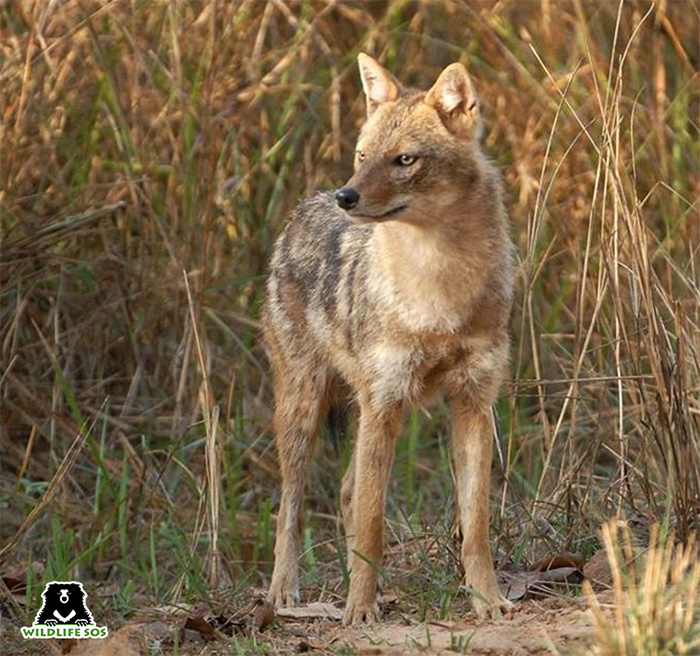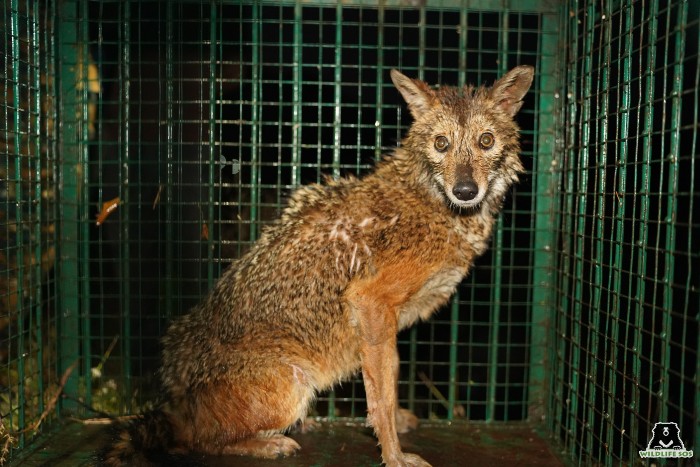Wildlife SOS profiles The Golden Jackal!
Jackals are one of the most underappreciated mammals found in India. Did you know that the Golden jackal (Canis aureus) is an extremely widespread canid in the country? But there’s a catch to this. The Golden jackal actually has seven subspecies, of which the one found most in India is the Indian Jackal (C.a. indicus). The C.a. aureus, commonly known as the Persian Jackal, is another subspecies that is found in small numbers only in the western part of India.
These wild canids hold a special place in the ecological food web. But just like a lot of other species, they too are a victim of human ignorance and find themselves stuck in the cesspool of myths and superstitious beliefs. Here, we shed some light on an animal that shares its neighbourhood with humans, but not many know about them.
Where Jackals are Found
When it comes to canid species, the wolves and the foxes take the most amount of limelight, largely due to their widespread coverage in pop culture and media. In order to bring them into focus, we need to know them better. In India, the jackal is quite adaptable, and can be found across varying terrains and landscapes.
 The Indian Jackal’s distribution range includes India, Bangladesh, Nepal and Bhutan. In India, this subspecies is found in a lot of regions. While the Golden jackal is definitely an animal of the jungle, such as the in Aravallis and the Kanha National Park, it is quite adaptive and can be spotted near densely populated cities such as Delhi, Gurgaon and Agra. But these canids also find shelter near smaller towns, villages, agricultural fields and even edges of semi-arid regions.
The Indian Jackal’s distribution range includes India, Bangladesh, Nepal and Bhutan. In India, this subspecies is found in a lot of regions. While the Golden jackal is definitely an animal of the jungle, such as the in Aravallis and the Kanha National Park, it is quite adaptive and can be spotted near densely populated cities such as Delhi, Gurgaon and Agra. But these canids also find shelter near smaller towns, villages, agricultural fields and even edges of semi-arid regions.
The Indian Jackal is not the only jackal subspecies found in the country. The Persian Jackal is found in parts of western India because one of the countries in its distribution range is Pakistan. The geography, therefore, allows for a continuous habitat from Pakistan into western India, particularly the Kumaon region of the Himalayas.
Even though marginal, a trained eye can tell the difference between the two subspecies as the Indian Jackal is larger in size and more brightly coloured. Adults grow up to 39 inches in length, 14-18 inches in height and weigh 8-11 kg.
Behaviour and Diet go Hand in Hand
Their physical characteristics play a huge role in how they behave and eat. The jackal’s long legs and lissom body allow them to cover great distances – almost 12-15 km in a single day – in search of the next meal. Since their diet is omnivorous and they can scavenge as well, it opens up a plethora of options on the menu. Their diet consists of rodents, small reptiles and insects. When meat is not on the menu, they even resort to fruits such as the Jujube and Java plum.
Jackals are social, and family groups of up to 4-5 individuals have been recorded. These small packs then work together to sometimes hunt small deer and antelopes. Jackals engage in greetings, grooming and group howling, which again indicates their social nature. The howling is used during breeding as well as to fend off intruders to defend their territories.
We have heard of the term ‘lone wolf’, but did you ever think that ‘lone jackal’ is a reality too? Solitary jackals banished from their pack have been known to form commensal relationships with tigers. These jackals are termed as kol-bahl and bhálú in southern India, phéall, phao or phnew in West Bengal and ghog in other regions. What they do is trail a particular tiger at a safe distance in order to feed on their kills. A kol-bahl can also spot prey and alert a tiger to make its kill. Such a mutually beneficial relationship is what prompts tigers to tolerate these solitary jackals.
These highly intelligent animals are more important than we think. In the ecosystems they inhabit, their role in the food chain is indispensable. Their occasionally scavenging nature helps in the organic degradation of a carcass in the wild, whereas their habit of sometimes feeding on fruits helps in seed dispersal. The species is protected under Schedule II of the Wildlife (Protection) Act, 1972 and their wild population is estimated to be 80,000. Though encouraging, their numbers in the wild should not allow us to let our guard down, as habitat loss and fragmentation due to deforestation, hunting, wildlife trafficking, human-wildlife conflict and road accidents threaten their existence.
Wildlife SOS and Jackal Conservation
Unless the above-mentioned threats are addressed, their population will continue to be battered by the tornado of infrastructure development. To that end, Wildlife SOS has conserved this species through thorough and sincere rescue operations. Delhi-NCR is a prime habitat for Golden jackals due to the presence of the Aravallis. But as cities started replacing the primeval forests of India’s oldest mountain range, the jackals were forced to adapt. It is not that the jackals entered cities, rather the cities have encroached upon the jackals’ homes instead.
The Wildlife SOS Rapid Response Unit in Delhi-NCR has rescued jackals from numerous predicaments. Recently, the NGO rescued a young male jackal from a medical store in Delhi’s Adchini area. The animal had sustained minor injuries on the stomach, presumably caused by stray dog attacks. He was then shifted to the NGO’s treatment facility and provided immediate medical aid.
In March 2022, a Golden jackal was left with grievous injuries from a piece of metal clutch wire wrapped tightly around the right forelimb. The NGO’s Rapid Response Unit rushed to the location and rescued the individual from Sainik Farms area. Wildlife SOS veterinarians removed the wire and treated the jackal, and it was later released back into the wild.
Life and Death Situation
The plight of the Golden jackal does not end here. Open wells also jeopardise their lives immensely. In November 2022, a jackal was found stuck inside a 40-foot-deep, dry borewell in Karbhana village near Agra. After an hour-long effort, the team finally extricated the animal safely. An on-site medical assessment by the veterinarian did not find any health concerns and we released the animal back into the wild.
 In another scenario last month, a Golden jackal was found trapped inside a 25-foot-deep open well in Inglun village, situated in Junnar division of Maharashtra. Wildlife SOS reached the spot on time and along with the Maharashtra Forest Department, rescued the jackal in a 2-hour-long operation. After our veterinarian conducted an on-site health assessment, the animal was released back into the wild.
In another scenario last month, a Golden jackal was found trapped inside a 25-foot-deep open well in Inglun village, situated in Junnar division of Maharashtra. Wildlife SOS reached the spot on time and along with the Maharashtra Forest Department, rescued the jackal in a 2-hour-long operation. After our veterinarian conducted an on-site health assessment, the animal was released back into the wild.
However, not all rescues have a happy ending. Our team in Maharashtra recently rescued a male Golden jackal found injured due to a road accident, adjacent to a highway in Junnar. He was brought in for treatment at the Manikdoh Leopard Rescue Centre, but despite our team’s best efforts, the jackal did not make it. The accident had caused severe trauma leading to spinal damage and internal blood loss. This is a tragedy of immeasurable proportions, but instead of getting demotivated, we have to keep working to improve our surroundings so that wild animals can move freely. You too can contribute towards this cause and help us in our rescue efforts by becoming a monthly donor for Wildlife SOS.
